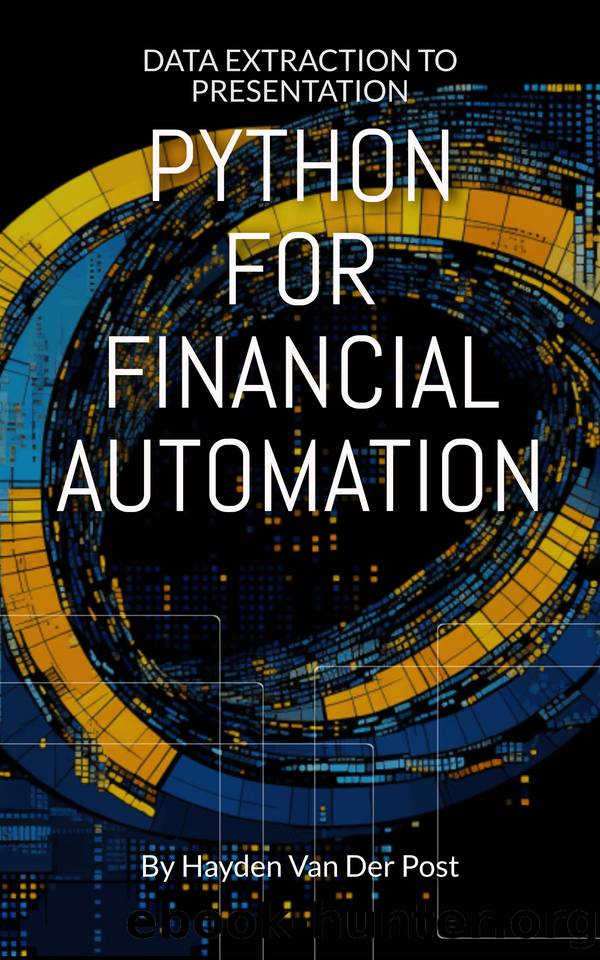Python For Financial Automation: Data Extraction To Presentation by Van Der Post Hayden

Author:Van Der Post, Hayden
Language: eng
Format: epub
Published: 2023-10-16T00:00:00+00:00
Chapter 6: Automation and Scripting for Financial Tasks
Python Scripting Basics
As we pivot into the most actionable section of our journey - automating financial tasks - it's vital first to grasp the foundations of Python Scripting. Python's popularity in finance is tremendously attributed to its capability to create scripts - small programs written to automate tasks. Python scripts are diverse, fast, and they bypass the extensive coding required in traditional programming languages, making them instrumental for financial professionals craving for efficiency and accuracy.
The world of Python scripting opens with a basic understanding of Python Syntax. Syntax, in programming, refers to the set of rules that dictate how programs in a language must be written. Python's syntax is designed for readability, a factor that significantly contributes to the language's learning simplicity. With Python, emphasis is on using English keywords rather than punctuation, and its clean, indent-based scoping system makes Python scripts clear and easy to read.
The true power of Python scripting lies in its proficiency to handle repetitive tasks or 'loops.' In finance, we often handle data that involves repeated calculations, such as calculating the performance of a portfolio over multiple time periods. Python's 'for' and 'while' loops execute blocks of code over and over again, based on conditions we set, making these repetitive tasks swift and simple.
Another Python scripting cornerstone is its incredible array of in-built functions - pre-written pieces of code designed to execute a particular task. Examples include the 'print()' function for outputting text or 'len()' function for getting the number of items in a list. These built-in functions save time, improve code readability, and reduce the likelihood of error, benefits that resonate deeply within financial workflow settings where efficiency and accuracy are paramount.
Aside from built-in functions, Python also allows you to create custom functions using the 'def' keyword. Imagine a scenario where you need to calculate the compound annual growth rate (CAGR) for various assets repeatedly. You could write a custom function to perform this calculation and then call the function every time you need to compute the CAGR. This dramatically reduces the chances of making a mistake and maintains your code clean and concise.
Python scripts can also interact with various types of files, an essential feature in finance where data may come in different formats such as CSV, Excel, or database outputs. Python's 'os' and 'sys' libraries handle file and directory interactions, including opening, reading, writing, and closing files, indispensable for finance professionals dealing with data from disparate sources.
Lastly, but equally important, error handling in Python scripts ensures that your scripts can handle unexpected situations gracefully. With Python's 'try', 'except', and 'finally' keywords, you can anticipate possible errors and define relevant responses, thereby ensuring your financial scripts are robust and reliable.
In essence, Python script's simplicity, versatility, and efficiency forma compelling case for its utilization in automating financial tasks. The fundamentals outlined here provide a strong base to delve deeper into the world of financial task automation using Python. The journey ahead will deploy these basics into practical, empowering you to automate, streamline, and enhance your financial analysis tasks.
Download
This site does not store any files on its server. We only index and link to content provided by other sites. Please contact the content providers to delete copyright contents if any and email us, we'll remove relevant links or contents immediately.
| Corporate Finance | Crowdfunding |
| Financial Engineering | Financial Risk Management |
| Wealth Management |
The Black Swan by Nassim Nicholas Taleb(6719)
Bad Blood by John Carreyrou(6245)
Pioneering Portfolio Management by David F. Swensen(6036)
Millionaire: The Philanderer, Gambler, and Duelist Who Invented Modern Finance by Janet Gleeson(4047)
Skin in the Game by Nassim Nicholas Taleb(3941)
The Money Culture by Michael Lewis(3791)
Bullshit Jobs by David Graeber(3786)
Skin in the Game: Hidden Asymmetries in Daily Life by Nassim Nicholas Taleb(3695)
The Wisdom of Finance by Mihir Desai(3494)
Blockchain Basics by Daniel Drescher(3292)
Liar's Poker by Michael Lewis(3192)
The Intelligent Investor by Benjamin Graham Jason Zweig(2908)
Hands-On Machine Learning for Algorithmic Trading by Stefan Jansen(2905)
Mastering Bitcoin: Programming the Open Blockchain by Andreas M. Antonopoulos(2868)
Fooled by Randomness: The Hidden Role of Chance in Life and in the Markets by Nassim Nicholas Taleb(2833)
Investing For Dummies by Eric Tyson(2770)
The Power of Broke by Daymond John(2741)
Market Wizards by Jack D. Schwager(2518)
Zero Hour by Harry S. Dent Jr. & Andrew Pancholi(2513)
